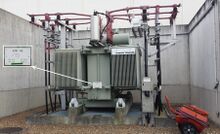Proposal:Transformers classification refinement
| Transformers classification refinement | |
|---|---|
| Proposal status: | Approved (active) |
| Proposed by: | fanfouer |
| Tagging: | transformer=* |
| Applies to: | |
| Definition: | Refine power transformers classification as to make it clearer and remove redundancies with substation=* |
| Statistics: |
|
| Draft started: | 2021-07-13 |
| RFC start: | 2021-08-09 |
| Vote start: | 2022-02-07 |
| Vote end: | 2022-02-21 |
Power transformers classification was introduced by Proposed_features/Substation_refinement in 2013.
It was then extended in 2017 with Proposed_features/Transformer_extension_proposal.
Experience and past discussions show it contains some redundancies/inconsistencies with substation=* and we could improve it with simple changes at a limited extent.
Proposal
Power transformers current classification is done with transformer=* on OSM.
It isn't consistent and mixes proper roles, substations roles and special design constraints.
It is proposed to change transformer=* reviewed values as follow:
- Introduce a new value transformer=main, consistent with transformer=auxiliary, to replace transformer=distribution only for transformers in a substation and transformer=traction every time. It will be the default value.
- Introduce a new tag windings:auto=yes to specify a given transformer is an auto-transformer, whatever its actual role (main, converter...) could be.
- Deprecate existing transformer=traction and transformer=auto
transformer=distribution will still be valid for standalone transformers on top of power poles, when they're not in a wider substation.
This will limit the amount of edits to be done as there are 94k of transformer=distribution on top of a pole, among 110k total usage.
transformer=auxiliary will still be valid for substations premises but also valid for any remote operator's premise as well. We may find very small auxiliary transformer on top of poles as well, to feed switching remote control capabilities.
Rationale
Transformers are devices that can be installed in a substation but they also can remain stand-alone, on top of a pole for instance.
Transformers classification should focus on particular roles of those devices when involved in a power substation and don't duplicate substations roles.
Currently, only a few transformer=* values got their corresponding substation=*. Mappers may be confused to find the right one instead of looking to transformer's grid connection on aerial imagery every time.
Most of the time, in most substations, they can be main or auxiliary transformers, respectively when they forward power to the grid with appropriate connection (as seen on aerial pictures) or to feed local substation's control systems from power grid.
Such a refinement will provide OSM with more objective, common and verifiable data instead of now.
On the picture upside, it is possible to destinguish main and auxiliary transformers according to two visual properties:
- Main transformers forward power between two or more different power grids (here between 63 000 volts <=> 225 000 volts sections and from 63 000 volts to distribution grid in blue), auxiliaries are branched on one particular voltage feeding another main unit.
- Main transformers are way bigger than auxiliary ones, due to their bigger power rating
Particular situations require to use generator (602-02-31) or converter transformers which are legit to be distinguished.
Minor distribution transformers
Minor distribution transformers are intended to feed individual consumers from a power distribution grid.
They can be installed in numerous substations or remain stand-alone on top of a pole.
Proposed changes has the advantage to prevent mixing transformer=distribution and substation=minor_distribution for the same facility.
Some consumers argue they are confused between distribution and minor_distribution.
Current tagging practice shows that it's usual to use transformer=distribution on stand-alone transformers but not for devices in actual substations.
Rate establishes at 113k/132k (85%) occurrences for stand-alone transformers.
Auto-transformers
auto-transformers (421-01-11) only relates to special arrangements of their winding and could be used for mostly all roles.
You could find such auto-transformers in distribution, transmission, traction or converter substations.
It encourages to replace transformer=auto by windings:auto=yes to let mappers state if it's a main or auxiliary transformer while stating it's an actual auto-transformer.
Auto design could be achieved with star, delta or others winding arrangements, then it's not possible to simply add windings:configuration=auto.
windings:auto=yes allows combinations with windings:configuration=star, windings:configuration=delta as to state the actual windings arrangements.
A special sign allows to visually and safely distinguish auto-transformers from standard ones. See picture beside.
Traction transformers
Traction transformers are defined in OSM as devices transforming electricity to feed (mostly train) traction systems. No IEC definition relates to this statement and despite such a transformer may have different architecture than ones used in public grids, it doesn't particularly make it special for traction. The same can be found in heavy industries or different situations.
Furthermore, Traction substation, regarding the facility in which devices are installed to feed train traction systems is defined by IEC in 605-01-06. It sounds more correct to deal with traction substations instead of traction transformers. Proposed changes won't prevent to find transformers dedicated to traction by looking to transformer=main located inside substation=traction.
transformer=traction (830 uses as of 2022-02-07) is way less used than substation=traction (5 625 uses as of 2022-02-07). It shows a clear interest in the last and encourage looking how overlapping those two tags are. As of 2022-02-07, 638 transformer=traction are inside substation=traction perimeters.
Tagging
Guidelines to map power=transformer don't change.
Here is the list of reviewed values for transformer=* as it will be if this proposal is approved
| Key | Value | Substation | Pole mounted | Comment |
|---|---|---|---|---|
| transformer | main (proposed) | yes | no | Default value. Main transformers forward power between different voltage parts of a substation independently connected to power grid. |
| auxiliary (existing, scope proposed to be extended) | yes | yes | Auxiliary transformers intend to supply power to local substation's internal systems or any remote operator's premises. They're not feeding any subscriber connected to power grid but act as a load on the network. | |
| generator (existing) | yes | no | A generator unit transformer connects directly to the generator terminals and is used for stepping up the generator voltage to that of the transmission grid. It is almost always located physically close to the generator typically directly outside the generator building. Unless the generator terminal voltage is known it is sufficient to tag only voltage:secondary=*. | |
| converter (existing) | yes | no | A converter transformer is a special main transformer used in HVDC converter plants. It is always located directly adjacent to the valve hall. If the voltage of the valve side is unknown it is sufficient to tag the AC switchgear side voltage in voltage:primary=*. | |
| phase_angle_regulator (existing) | yes | no | A phase angle regulator is a special main transformer for controlling the flow of power in a three-phase network by shifting the phase angle. | |
| distribution (existing, scope proposed to be changed) | no | yes | A distribution transformer transfers power from the distribution system to directly connected electricity consumers. Thus the output voltage is that of the low voltage grid in that region. For example 400/230 volt in Europe or 240/120 volt in the US. This class is used outside of proper substations (they would be main in a substation). Note for pole/tower mounted distribution transformers you should use this tag together with power=pole or power=tower (thus no explicit power=transformer tag). | |
| yes (existing) | yes | yes | This generic value may be used to tag a transformer attached to another power feature such as a power pole (since power=transformer cannot be tagged in such cases). It is however recommended to specify the type of transformer (such as distribution) also in this case but mappers not familiar with the different roles of transformers may use the value yes. |
Change management
Affected pages
- Edit power=transformer to update classification guidelines
- Edit transformer=distribution to update scope, outside substations only
- Edit transformer=auxiliary to extend perimeter of this value, not only in substations but next to remote switches as well.
- Create transformer=main and define it as the default value of transformer=*
- Create windings:auto=yes
- Deprecate transformer=traction
- Deprecate transformer=auto
Values to be replaced
| Obsolete tag | Usage | Used for ? | New tag(s) to use |
|---|---|---|---|
| transformer=traction | 830 on 2022-02-07 | A transformer feeding train traction systems, in a substation=traction facility | transformer=main (+ substation=traction on the surrounding perimeter). As a comparison, substation=traction is used 5 625 as of 2022-02-07. |
| transformer=distribution | approx 15 000 on 2021-12-06 | A transformer feeding whether consumers or distribution networks, in a wider substation=distribution or substation=minor_distribution substation | transformer=main (+ substation=distribution or substation=minor_distribution on the surrounding perimeter depending on the situation) |
| transformer=minor_distribution | 3 008 on 2022-02-07 | A transformer feeding whether consumers or distribution networks, in a wider substation=minor_distribution substation | transformer=main (+ substation=minor_distribution on the surrounding perimeter depending on the situation) |
| transformer=minor_distribution | 3 008 on 2022-02-07 | A transformer feeding whether consumers or distribution networks at the top of a pole, outside of any substation | transformer=distribution |
| transformer=auto | 1 681 on 2022-02-07 | An auto-transformer used as a main transformer | windings:auto=yes + transformer=main |
| transformer=auto | 1 681 on 2022-02-07 | An auto-transformer used as an auxiliary transformer (uncommon) | windings:auto=yes + transformer=auxiliary |
External discussions
- Substation nodes extension Talk asking to make this proposal prior voting.
- Tagging mailing-list - August 2021.
Examples
This is updates of power=transformer examples.
Transmission transformers
| Photo | Location | Tagging | Note |
|---|---|---|---|
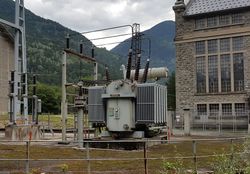 |
France |
|
This transformer intends to step up 6kV power output from a hydroelectric power plant with 2 generator units to the 63kV local power grid.
|
 |
Germany |
|
Large outdoor power transformer in a transmission power substation |
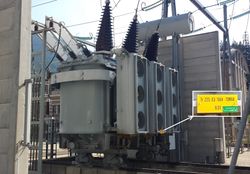 |
France |
power=transformer
|
This transformer has 3 windings operating at 3 different voltages. 225kV side is on the foreground while 63kV is hidden at the back
|
 |
France |
power=transformer
|
This plate can be seen on transformer themselves (picture taken with power grid operator acknowledgement) and gives the windings configuration with several other figures. All tags can be defined with it.
|
Distribution transformers
| Photo | Location | Tagging | Note |
|---|---|---|---|
 |
Denmark |
|
Typical pole mounted 10 kV transformer. |
 |
France |
power=pole
|
Transformers can directly be hosted on poles to save ground place and prevent complex infrastructure building when not needed. |
 |
United States |
power=pole
|
Multiple mono phase transformers used on a 3-phase network |
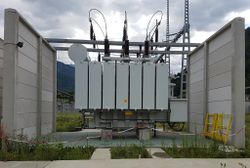 |
France |
power=transformer
|
|
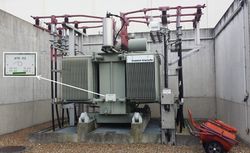 |
France |
power=transformer
|
Such transformer are used in France to feed legacy 15kV distribution zones from current 20kV infrastructures.
|
| Norway |
|
A distribution transformer seen outdoor in Norway with figures displayed on the red plate |
Traction transformers
We use to call them traction transformer, but they are first of all standard transformer, used in a traction substation
| Photo | Location | Tagging | Note |
|---|---|---|---|
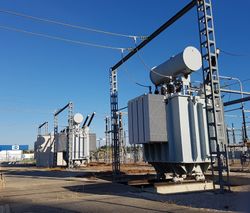 |
France |
power=transformer
|
High speed rail lines are fed from transmission power grid with such biphase transformers.
|
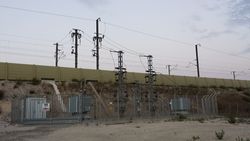 |
France |
On one of each transformer inside of the substation
power=transformer
|
Due to pretty long distances, high speed rail 25kV contact lines have to be regularly fed by auto-transformers which take power from a -25kV feeder line going along railways. |
Auxiliary transformers
| Photo | Location | Tagging | Note |
|---|---|---|---|
 |
France |
power=transformer
|
Two auxiliary transformers, tagging is valid for the bigger white one. The smaller grey one convert from 20kV to 400V to feed the substation's premises only. |
 |
France |
power=pole
|
Some remote switches mostly installed on distribution networks can be found on top of poles. Some of them are remotely controllable and need power to operate. A small transformer is installed on the pole to get its power directly from the network. It acts as an auxiliary transformer to feed the local operator's premises without ay subscriber connected. |
Voting
Voting on this proposal has been closed.
It was approved with 19 votes for, 0 votes against and 1 abstention.
 I approve this proposal. --GeoMechain (talk) 08:25, 8 February 2022 (UTC)
I approve this proposal. --GeoMechain (talk) 08:25, 8 February 2022 (UTC) I approve this proposal. --WalkerB (talk) 08:41, 8 February 2022 (UTC)
I approve this proposal. --WalkerB (talk) 08:41, 8 February 2022 (UTC) I approve this proposal. --Ydel (talk) 08:52, 8 February 2022 (UTC)
I approve this proposal. --Ydel (talk) 08:52, 8 February 2022 (UTC) I approve this proposal. --- Kovposch (talk) 09:47, 8 February 2022 (UTC)
I approve this proposal. --- Kovposch (talk) 09:47, 8 February 2022 (UTC) I approve this proposal. --Fanfouer (talk) 14:16, 8 February 2022 (UTC)
I approve this proposal. --Fanfouer (talk) 14:16, 8 February 2022 (UTC) I approve this proposal. --Dr Centerline (talk) 22:39, 8 February 2022 (UTC)
I approve this proposal. --Dr Centerline (talk) 22:39, 8 February 2022 (UTC) I have comments but abstain from voting on this proposal. Infrastructure/Power is a niche OSM subject. As a general mapper I am far from qualified to approve or disapprove. Does this proposal have the approval of members of Infrastructure-mapping subgroups? Have they been alerted that a change is proposed? (perhaps the names listed above are those people) Jnicho02 (talk) 10:07, 9 February 2022 (UTC)
I have comments but abstain from voting on this proposal. Infrastructure/Power is a niche OSM subject. As a general mapper I am far from qualified to approve or disapprove. Does this proposal have the approval of members of Infrastructure-mapping subgroups? Have they been alerted that a change is proposed? (perhaps the names listed above are those people) Jnicho02 (talk) 10:07, 9 February 2022 (UTC) I approve this proposal. --AnakinNN (talk) 19:41, 9 February 2022 (UTC)
I approve this proposal. --AnakinNN (talk) 19:41, 9 February 2022 (UTC) I approve this proposal. --Russss (talk) 16:22, 10 February 2022 (UTC)
I approve this proposal. --Russss (talk) 16:22, 10 February 2022 (UTC) I approve this proposal. --JacquesLavignotte (talk) 15:11, 12 February 2022 (UTC)
I approve this proposal. --JacquesLavignotte (talk) 15:11, 12 February 2022 (UTC) I approve this proposal. --PanierAvide (talk) 16:49, 13 February 2022 (UTC)
I approve this proposal. --PanierAvide (talk) 16:49, 13 February 2022 (UTC) I approve this proposal. --Overflorian (talk) 08:18, 14 February 2022 (UTC)
I approve this proposal. --Overflorian (talk) 08:18, 14 February 2022 (UTC) I approve this proposal. Addresses an ambiguity in current tagging practices well. Good improvement, well thought out and defined.--Bert Araali (talk) 14:35, 14 February 2022 (UTC)
I approve this proposal. Addresses an ambiguity in current tagging practices well. Good improvement, well thought out and defined.--Bert Araali (talk) 14:35, 14 February 2022 (UTC) I approve this proposal. --Wetterauer (talk) 17:17, 14 February 2022 (UTC)
I approve this proposal. --Wetterauer (talk) 17:17, 14 February 2022 (UTC) I approve this proposal. --Kjon (talk) 11:16, 20 February 2022 (UTC)
I approve this proposal. --Kjon (talk) 11:16, 20 February 2022 (UTC) I approve this proposal. --EneaSuper (talk) 11:22, 20 February 2022 (UTC)
I approve this proposal. --EneaSuper (talk) 11:22, 20 February 2022 (UTC) I approve this proposal. --Atarom (talk) 16:04, 20 February 2022 (UTC)
I approve this proposal. --Atarom (talk) 16:04, 20 February 2022 (UTC) I approve this proposal. --Alexmol (talk) 19:40, 20 February 2022 (UTC)
I approve this proposal. --Alexmol (talk) 19:40, 20 February 2022 (UTC) I approve this proposal. --Gendy54 (talk) 19:52, 20 February 2022 (UTC)
I approve this proposal. --Gendy54 (talk) 19:52, 20 February 2022 (UTC) I approve this proposal. Once again a well documented and clean proposal improving the tagging. Thanks for your work. --Skyper (talk) 16:04, 21 February 2022 (UTC)
I approve this proposal. Once again a well documented and clean proposal improving the tagging. Thanks for your work. --Skyper (talk) 16:04, 21 February 2022 (UTC)

